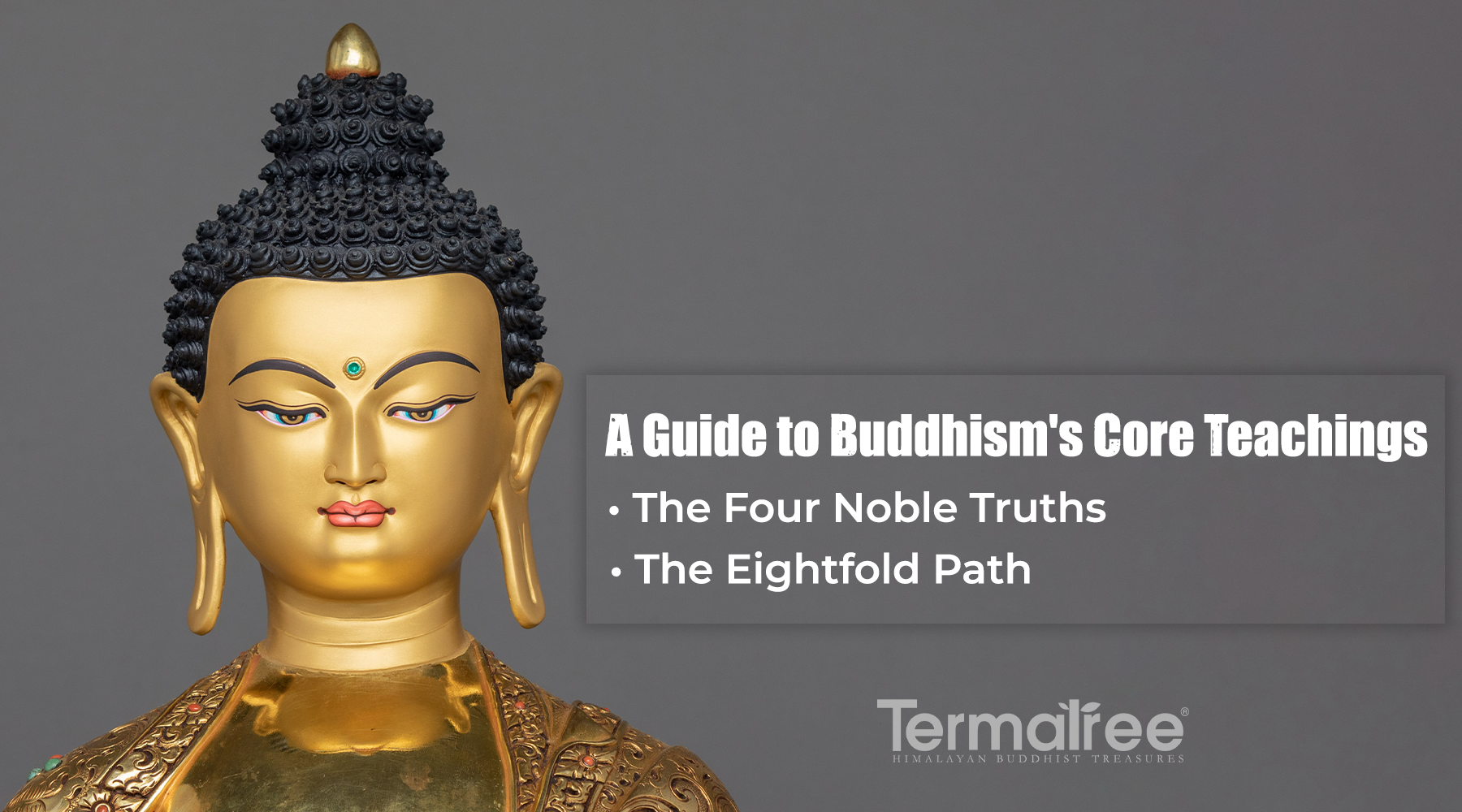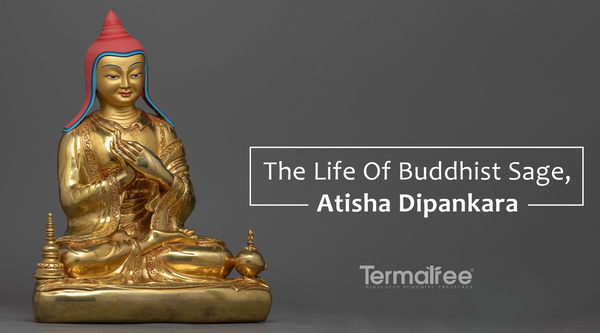Millions of people around the world have changed their lifestyles and relationship with themselves and started living a more spiritual and mindful life after discovering Buddhism. The conversion varies; some add a simple daily meditation to their everyday life, while some give up their normal life and start anew in monasteries, an ascetic lifestyle. There are approximately more than 450 million Buddhists worldwide; however, the Buddhist teachings, or the Dharma, aren't just for religious endeavors and devotees but for everyone who desires to make sense of their existence in this world in a more spiritual and mindful manner.
A rundown of Buddhism, it started with the enlightenment of Gautama Buddha, born Siddhartha Gautama, in Nepal, which soon spread to neighboring countries and eventually all around the world. 'Buddha' stands for 'the awakened one,' 'the wise one,' closely related to 'Buddhi' (intellect, wisdom, etc.) given to anyone who attains enlightenment, or Nirvana. Buddha symbolizes the liberation of the soul from dukkha, the suffering of the world. At its core, Buddhism is a path toward greater understanding and liberation from suffering, a path that is open to all who seek it. And it is succinctly captured in Buddha's Four Nobles' Truths (Pāli: cattāri ariyasaccāni), the reality of human existence and the ultimate way to alleviate suffering.
What are the four noble truths?
The foundation of Buddhist philosophy, the Four Noble Truths, provides a framework for understanding the nature of suffering and how to overcome it. They are referred to as "Noble Truths" because they are true (tathni), error-free (avitathni), and constant (anaathni). They are:
The Truth of Suffering (dukkha sacca): Suffering or dukkha is an inherent part of life; the first truth highlights the existence of this suffering. This encompasses emotional and existential pain from life's transience- the dissatisfaction of living. Whether be it physical or emotional, suffering is a fundamental fact of life- it is ubiquitous. However, the comprehension of this truth is not straightforward; it requires a nuanced and multi-layered understanding of the nature of suffering. And it is when one recognizes that one is of the nature of suffering when one acknowledges and accepts this reality of suffering that one can begin to overcome it.
The Truth of the Cause of Suffering (dukkha-samudāya sacca): The truth of the cause of suffering, or dukkha, is the attachment to the organic elements, i.e., the earthly materials and worldly pleasures. Such cravings and obsessions with worldly possessions (could be materials or ideals) is the origination of suffering that originates suffering. Attachment to anything is bound to cause the inevitable experience of suffering when it is lost or disappoints our expectations. We are trapped in our constant need for pleasure and gratification that only further reinforces our suffering and pain; hence understanding this suffering is the first step to overcoming it.
The Truth of the Cessation of Suffering (dukkha-nirodha sacca): Releasing oneself from attachment is the only way to put an end to desire, which results in dukkha. This potential for emancipation from suffering is the third Noble Truth. Only when we let go of attachment and craving by cultivating mindfulness and compassion are we able to liberate ourselves from suffering and end the cycle of life. However, this doesn't mean one to become apathetic or indifferent, but rather that we should seek a deeper and more meaningful sense of contentment.
The truth of the Path to the Cessation of Suffering (dukkha-nirodha-gamini-paṭipadā sacca): The final Noble Truth identifies and puts forth techniques and remedies for effective cessation of suffering and affliction. The Buddha taught an analysis of the origins of suffering based on ignorance concerning the three characteristics of sentient existence - suffering, impermanence, and non-self. This ignorance leads to the formation of attachments, such as desire and aversion, which strengthen ignorance about the true nature of sentient existence, perpetuating the cycle of rebirth, old age, disease, and death. The cure for such ignorance consists of a set of principles called the Eightfold Path, also referred to as the Middle Way, that avoids two extremes - excessive indulgence and severe asceticism - both of which failed to aid the Buddha in his pursuit of enlightenment.

Click here to view our Gold Gilded Shakyamuni Buddha Statues
What is the Eightfold Path?
The Noble Eightfold Path is a fundamental teaching of Buddhism; the Buddha's teachings primarily revolve around these paths in some form or another. These paths consist of eight interconnected, irrelevant to the numbering practices that ultimately lead to liberation from suffering. It acts as a practical guide for those seeking spiritual enlightenment and attaining inner peace. It can be understood as the practical application of Buddhist teachings. Buddha himself explained these eight paths according to the listener's capacity for understanding as it is a set of guidelines that would allow people to incorporate the more philosophical and spiritual essence in daily life. The eight aspects of the path are:
Right understanding: Cultivate right understanding, i.e., a deep understanding of the Four Noble Truths and the nature of reality which is the fundamental foundation of Buddhist philosophy. By comprehending the nature of suffering, its causes, and the path to its cessation, one can transcend the rebirth cycle and liberate oneself.
Right intention: Nurture good and wholesome intentions aligned with the path to enlightenment. Cultivating compassion, loving-kindness, and the intention to renounce harmful behavior. One should endeavor for deep insight and wisdom.
Right speech: Abstain from lying, gossiping, harsh language, and divisive speech, and rather speak truthfully, kindly, and skillfully that promotes harmony and understanding.
Right action: Inculcate ethical actions and avoid harmful behaviors like killing, stealing, and sexual misconduct. One should rather cultivate actions that promote peace, compassion, and well-being.
Right livelihood: One should earn a living in a way that is ethical, consistent with Buddhist principles, and aligned with one's spiritual values. Avoid any occupation that harms other sentient beings and pursue one that promotes society's overall well-being and contributes positively.
Right effort: One should strive for and make a sustained effort to cultivate positive qualities to eventually overcome negative ones. It is the perseverance for one's spiritual practice through obstacles and challenges on the path to enlightenment.
Right mindfulness: Develop mindfulness and awareness of the present moment and refrain from judgmental attention and negative feelings. Mindfulness is necessary to practice emotionally, physically, and mentally to gain insight into the nature of reality.
Right concentration: The final practice on the Noble Eightfold Path is to cultivate deep concentration through meditation and other practices to gain insight into the nature of reality and the workings of the mind.





